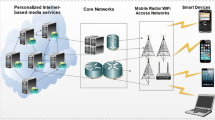Abstract
Providing ambient media services in the pervasive environments is a challenging issue. This is due to the fact that users have different satisfaction level in using different media services in varying contexts. We address this issue by proposing a gain-based media service selection mechanism. Gain refers to the extent a media service is satisfying to a user in a particular context. In our proposed mechanism, the gain is dynamically computed by adopting a user-centered approach that includes user’s context, profile, interaction history, and the reputation of a service. The dynamically computed gain is used in conjunction with the cost of using a service (e.g. media subscription and energy consumption cost) to derive our service selection mechanism. We adopt a combination of greedy and dynamic programming based solution to obtain a set of services that would maximize the user’s overall gain in the ambient environment by minimizing the cost constraint. Experimental results demonstrate the potential of this approach.










Similar content being viewed by others
References
Abowd GD, Mynatt, ED (2000) Charting past, present, and future research in ubiquitous computing. ACM Trans Comput-Hum Interact 7(1):29–58
Adomavicius G, Sankaranarayanan R, Sen S, Tuzhilin A (2005) Incorporating contextual information in recommender systems using a multidimensional approach. ACM Trans Inf Syst 23(1):103–145
Agrawal R, Imielinski T, Swami A (1993) Mining association rules between sets of items in large databases. In: ACM-SIGMOD Int. Conf. Management of Data. ACM, New York, pp 207–216
Atrey PK, Hossain MA, El Saddik A (2008) A method for computing the reputation of multimedia services through selection and composition. In: Fifteenth annual IS&T/SPIE conference on multimedia computing and networking, vol. 6818. SPIE, Bellingham, pp H1–H8
Billsus D, Pazzani MJ (2000) User modeling for adaptive news access. User Model User-Adapt Interact 10(2–3):147–180
Blache F, Chraiet N, Daroux O, Evennou F, Flury T, Privat G, Viboud JP (2003) Position-based interaction for indoor ambient intelligence environments. In: First European symposium on ambient intelligence, Veldhoven, 3–4 November 2003, pp 192–207
Boutemedjet S, Ziou D (2008) A graphical model for context-aware visual content recommendation. IEEE Trans Multimedia 10(1):52–62
Brown P, Jones G (2001) Context-aware retrieval: exploring a new environment for information retrieval and information filtering. Pers Ubiquitous Comput 5(4):253–263
Busetta P, Kuflik T, Merzi M, Rossi S (2004) Service delivery in smart environments by implicit organizations. In: 1st Annual international conference on mobile and ubiquitous systems: networking and services, Boston, 22–25 August 2004, pp. 356–363
Dey A (2001) Understanding and using context. Pers Ubiquitous Comput 5(1):4–7
Ducatel K, Bogdanowicz M, Scapolo F, Leijten J, Burgelman JC (2001) Scenarios for ambient intelligence in 2010. IST advisory group final report. ftp://ftp.cordis.lu/pub/ist/docs/istagscenarios2010.pdf
Georgantas N, Mokhtar SB, Bromberg YD, Issarny V, Kalaoja J, Kantarovitch J, Grodolle A, Mevissen R (2005) The amigo service architecture for the open networked home environment. In: WICSA. IEEE Computer Society, Washington, DC, pp 295–296
Han J, Kamber M (2000) Data mining: concepts and techniques. Morgan Kaufmann, San Mateo
Hossain MA, Atrey PK, El Saddik A (2007) Smart mirror for ambient home environment. In: 3rd IET international conference on intelligent environments, Ulm, 24–25 September 2007, pp 589–596
Hossain MA, Atrey PK, El Saddik A (2008) Management of ambient media preferences in distributed environments for service personalization. In: Proceedings of the international symposium on parallel architectures, algorithms, and networks, vol 0. IEEE, Piscataway, pp 204–209
Lashina T (2004) Intelligent bathroom. In: European Symposium on Ambient Intelligence, Eindhoven, 8–11 November 2004
Lindenberg J, Pasman W, Kranenborg K, Stegeman J, Neerincx MA (2006) Improving service matching and selection in ubiquitous computing environments: a user study. Pers Ubiquitous Comput 11(1):59–68
Loke SW, Krishnaswamy S, Naing TT (2005) Service domains for ambient services: concept and experimentation. Mob Netw Appl 10(4):395–404
Magerkurth C, Etter R, Janse M, Kela J, Kocsis O, Ramparany F (2006) An intelligent user service architecture for networked home environments. In: 2nd IET International conference on intelligent environments, Athens, 5–6 July 2006
Martello S, Toth P (1990) Knapsack problems: algorithms and computer implementations. Wiley, New York
McBurney S, Williams MH, Taylor NK, Papadopoulou E (2007) Managing user preferences for personalization in a pervasive service environment. In: Proc. 3rd advanced intl. conf. telecommun., Mauritius, May 2007
Millard I, Roure DD, Shadbolt N (2005) Contextually aware information delivery in pervasive computing environments. In: Proceedings of the international conference on location and context-awareness, Oberpfaffenhofen, 12–13 May 2005, pp 189–197
Naresh V, Pingali P, Varma V, Krishna M, Venkata P (2006) Location based web search on GSM/GPRS mobile phones. In: Proceedings of WWW
Pasman W (2004) Organizing ad hoc agents for human-agent service matching. In: The first annual international conference on mobile and ubiquitous systems: networking and services. IEEE, Piscataway, pp 278–287
Schmidt A, Beigl M, Gellersen HW (1999) There is more to context than location. Comput Graph 23(6):893–901
Tyan J, Mahmoud QH (2005) A comprehensive service discovery solution for mobile ad hoc networks. Mob Netw Appl 10(4):423–434
Yu Z, Zhou X, Zhang D, Chin C, Wang X, Men J (2006) Supporting context-aware media recommendations for smart phones. IEEE Perv Comput 5(3):68–75
Zacharia G, Moukas A, Maes P (2000) Collaborative reputation mechanisms for electronic marketplaces. Decis Support Syst 29(18):371–388
Zhu F, Mutka MW, Ni LM (2005) Service discovery in pervasive computing environments. IEEE Perv Comput 4(4):81–90
Zhu M, Zhang D, Zhang J, Lim BY (2007) Context-aware informative display. In: IEEE international conference on multimedia and expo. IEEE, Piscataway, pp 324–327
Author information
Authors and Affiliations
Corresponding author
Rights and permissions
About this article
Cite this article
Hossain, M.A., Atrey, P.K. & El Saddik, A. Gain-based Selection of Ambient Media Services in Pervasive Environments. Mobile Netw Appl 13, 599–613 (2008). https://doi.org/10.1007/s11036-008-0092-y
Received:
Accepted:
Published:
Issue Date:
DOI: https://doi.org/10.1007/s11036-008-0092-y




